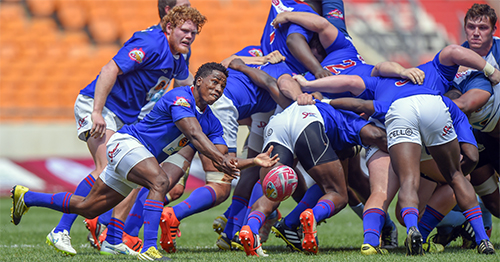
Scrumhalf Zee Mkhabela is one of the senior Shimla players who will have to help his team play three Varsity Cup matches within a week. Photo: Christaan Kotzé/SASPALuckily, he has a bunch of fighters in his rugby group to take on the week ahead, which is almost like a USSA rugby week with a lot of matches in a row.
This is what Hendro Scholtz, the Shimla coach, had to say about the upcoming Varsity Cup week, with his team playing three games within a week. His team will play against the University of Johannesburg (UJ) on 21 March 2016, after which they will face Maties in Cape Town on 24 March 2016, and then take on Pukke in the Mother City on 28 March 2016.
The schedule for the Varsity Cup series had to be adapted due to the recent unrest on campuses across South Africa.
According to Scholtz, the versatility of his players and the attitude of the University of the Free State (UFS) rugby team counts in their favour for the week that lies ahead. Several of the Shimla players can play in more than one position.
The Shimlas will travel with a group of 29 players, and will, after their match in the City of Gold, fly directly to Cape Town for their other two league matches.
“We will take six extra players (other than the 23-man squad) with us,” Scholtz said.
“One should select a group for this week that can fight, hang in there, and are able to play another match or two. It is like a USSA week where you need fighters.”
Prop Chase Morison, who was given a red card against the Central University of Technology in Johannesburg on 14 March 2016, wasn't sighted, and is available to play again. The Shimlas are still unbeaten after winning 10-9 against CUT in the FNB Stadium. Flyhalf Pieter-Steyn de Wet, who missed the game against CUT due to an injury, will be able to play against UJ.
The Kovsie Young Guns and Vishuis, the residence representative for the UFS, will also play a couple of matches in the coming week.
Fixtures:
Shimlas: 21 March: Shimlas v UJ (FNB Stadium); 24 March: Maties v Shimlas (Cape Town Stadium); 28 March: Puk v Shimlas (Cape Town Stadium).
Kovsie Young Guns: 19 March: Kovsie Young Guns v UJ (Rand Stadium); 24 March: Puk v Kovsie Young Guns (Rand Stadium).
Vishuis: 24 March: Vishuis tv Harlequins (NMMU, Rand Stadium); 26 March: Mopanie tv Vishuis (Tuks, (Wanderers Rugby Club); 28 March: Oppierif v Vishuis (UJ, FNB Stadium).